Azawakh
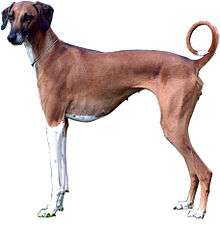 Typical Azawakh female | |||||||||||||||||||||||||||||||
| Other names |
Idi Hanshee Oska Rawondu Bareeru Wulo (formerly) Tuareg Sloughi | ||||||||||||||||||||||||||||||
|---|---|---|---|---|---|---|---|---|---|---|---|---|---|---|---|---|---|---|---|---|---|---|---|---|---|---|---|---|---|---|---|
| Origin | Mali, Egypt | ||||||||||||||||||||||||||||||
| Patronage | France | ||||||||||||||||||||||||||||||
| |||||||||||||||||||||||||||||||
| |||||||||||||||||||||||||||||||
| Domestic dog (Canis lupus familiaris) | |||||||||||||||||||||||||||||||
The Azawakh is a sighthound dog breed from Africa.
Description
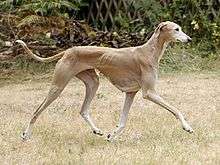
Appearance
Morphology is very similar to that of the Middle Eastern and South Indian sight hounds, all swift, high-bred coursing hounds, although there are several obvious differences. For example, a short, flat back combined with long legs place the hips higher than the withers. The Azawakh is almond eyed and thin. It moves with a distinctly feline gait and can be found in a variety of colors as well as varying degrees of refinement, though format is basically constant.
Height and weight
The standards call for a hound from 33 to 55 pounds (15 to 25 kg); its height is 24 to 29 inches (61 to 74 cm). The coat is very short and almost absent on the belly. Its bone structure shows clearly through the skin and musculature. Its muscles are "dry", meaning that they are quite flat, unlike the Greyhound and Whippet. In this respect it is similar in type to the Saluki.
Colors
In Africa, Azawakh are found in a variety of colors such as red, blue fawn (that is, with a lilac cast), grizzle, and, rarely, blue and black. The Azawakh in its native land also comes with various white markings including Irish marked (white collar) and particolor (mostly white).[1] Because of this wide color variation in the native population, the American standard used by the AKC and UKC allows any color combination found in Africa. In the United States, the FCI standard is modified to have no color restrictions at a minimum and there is a strong sentiment that the FCI standard should be heavily edited or replaced.[2]
Colors permitted by the FCI breed standard are clear sand to dark fawn/brown, red and brindle (with or without a dark mask), with white bib, tail tip, and white on all feet (which can be tips of toes to high stockings). Currently, white stockings that go above the elbow joint are considered disqualifying features in France, as is a white collar or half collar (Irish marked).
Movement
The Azawakh's light, supple, lissome gait is a notable breed characteristic, as is an upright double suspension gallop.
Health
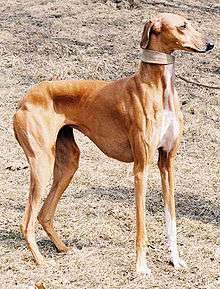
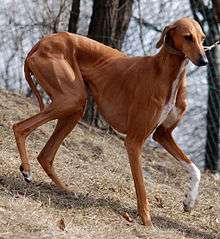
Azawakhs are an incredibly sound coursing hound. Serious coursing injuries are rare. The dogs heal very quickly from injury.
Azawakh have no known incidence of hip dysplasia. There is a small occurrence of adult-onset idiopathic epilepsy in the breed. Wobbler disease, or cervical vertebral instability, does rarely occur. Some breeders believe this is largely a developmental problem where puppies grow too quickly due to a high-protein Western diet.
Reproduction
Like the Basenji and Tibetan Mastiff, the Azawakh often has a single annual estrus. Unassisted birth of healthy puppies is normal. Litter sizes are usually from four to six puppies, but litters as small as one and as large as ten occur.
Care
Azawakh need a fairly high level of exercise and should have regular runs off lead in large enclosed areas to run off steam. The dogs are very social and emotional. They need a master that provides firm but fair leadership. Azawakh thrive on companionship of other Azawakh.
Temperament
Unlike other sighthounds, the primary function of the Azawakh in its native land is that of protector. It develops an intense bond with its owner, yet can perform independently from its master. With those they accept, Azawakh are gentle and extremely affectionate. With strangers many are reserved and prefer not to be touched, but are not inherently aggressive. Although raised to protect livestock, they do not have innate aggression toward canines or humans unless they are threatened.
Azawakh have high energy and tremendous endurance. They are excellent training companions for runners and are nearly impervious to heat. They will happily run in weather over 100 degrees Fahrenheit that would kill a Greyhound.
Many Azawakh dislike rain and cold weather.
Azawakh are pack oriented and form complex social hierarchies. They have tremendous memories and are able to recognize each other after long periods of separation. They can often be found sleeping on top of each other for warmth and companionship.[3]
Alberto Rossi: "To raise an Azawakh is like building a very fragile construction, which takes a lot of sensibility and can be destroyed from one minute to the next. But every minute it lasts, it fills you with great happiness." Every time I´m sitting in a chair or sofa at least one of my dogs tries to take a seat on my lap. The same happens to those of my guests which they love. In these moments they seem to be the image of calmness, gentleness, and trust. But one should not be deceived about this. In the deepest place of their soul resides something wild and native, and they will remind us about it with the first occasion and we should not forget, even for a moment, not to treat them like a normal dog."
History
Bred by the Tuareg, Fula and various other nomads of the Sahara and sub-Saharan Sahel in the countries of Mali, Niger, Burkina Faso, and southern Algeria, the breed is used there as a guard dog and to hunt gazelle and hare at speeds up to 40 miles per hour. The austerity of the Sahel environment has ensured that only the most fit dogs survive and has accentuated the breed's ruggedness and independence. Unlike some other sighthounds, the Azawakh is more of a pack hunter and they bump down the quarry with hindquarters when it has been tired out. In role of a guard dog, if an Azawakh senses danger it will bark to alert the other members of the pack, and they will gather together as a pack under the lead of the alpha dog, then chase off or attack the predator. The Sloughi, by comparison, is more of an independent lone hunter and has a high hunting instinct.
They are relatively uncommon in Europe and North America but there is a growing band of devotees. Azawakhs have a range of temperaments from lap dog to quite fierce. Lifelong socialization and firm but gentle handling are critical. Well socialised and trained, they can be good with other dogs, cats, children, and strangers. Azawakh may be registered with the FCI in the USA via the Federación Canófila de Puerto Rico (FCPR).[4] European FCI clubs and the AKC recognize the FCPR as an acceptable registry. The AKC currently recognizes Azawakh as a Foundation Stock Service[5] breed and they are eligible to participate in AKC-sanctioned Companion & Performance events. The breed will enter the AKC Miscellaneous Class on June 30, 2011. The American Azawakh Association (AAA).[6] is the AKC Parent Club for the Azawakh. Azawakh may be registered with the UKC and ARBA. The breed is not yet registered by CKC. Azawakh are eligible for ASFA and AKC lure coursing and NOFCA open field coursing events.
Origin
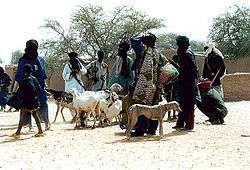
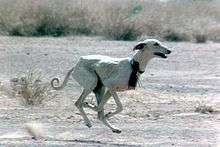
Genetic, blood protein and archaeological studies, as well as direct observation in the field, offer a glimpse into the origin of the contemporary Azawakh breed. It originated from the pariah dogs of sub-Saharan Africa—also called bush dogs or basenji—and is also closely related to the Sloughi of the Maghreb. Despite morphological similarities, mitochondrial DNA evidence shows that it is only very distantly related to other sight hounds. Azawakh have a rare glucose isomerase allele (GPIB) that occurs only in foxes, jackals, Italian wolves, Sloughi dogs and a handful of other quite unrelated rare dogs found mostly in Japan. The presence of the GPIB suggests an ancient differentiation of the Azawakh from other dog populations near the base of the dog family tree divergence from wolves or perhaps a uniquely African cross-breeding with local African canids such as jackals. Petroglyph rock art dating from 8,000 to 10,000 years ago during the Green Sahara (also known as the Holocene and Neolithic Subpluvial) shows cursorial dogs in conjunction with hunters. Archaeologists have found dog bones buried in Holocene settlements in the Sahara. At the close of the Holocene Wet Phase in the 4th millennium BCE, the Sahara returned to desert and created a formidable physical barrier to travel. Together, this evidence suggests that the Azawakh population has a unique genetic heritage that has been largely isolated from other dog populations for millennia.
In the common era the Sahel dogs are almost totally isolated from northern dogs by the Sahara, but the ties to the pariah dogs to the south are extremely close. Azawakh are virtually indistinguishable from the Sahel pariah dog population from which they are drawn. In addition to a basic physical structure, the Azawakh share a number of unique traits with the pariah dogs:
- intense suspicion of the unknown
- strong guarding instinct
- pack hunting behavior
- complex social hierarchies
- unique vocalizations
- extra pre-molar teeth
- strong instinct to dig dens
Throughout the Sahel, very elegant puppies can be found among rustic siblings. The Sahel nomads do not have the same breed concepts as in the West and, unlike the Bedouin of the North, do not recognize a strict separation of al hor (noble) from kelb (mongrel) dogs. The nomads act as an extra level of selection on top of the intense natural selection pressure of the Sahel environment. The approach to selection is diametrically opposed to Western breeding, and presents the advantage of maintaining a large reservoir of genetic variability and resilience.
The peoples of the Sahel control dam lines and cull puppies heavily at birth according to locally held aesthetic criteria that are not yet fully understood. In the Sahel, color is not a selection criterion. The alpha male dog from the local population is usually the sire. Females are usually culled unless the family projects a need for more dogs in the future.
References
- ↑ Tombouktous-azawakhs.de (German)
- ↑ 02/03/2009, Moore and Reiter, The Azawakh Club of America Archived December 13, 2011, at the Wayback Machine.
- ↑ Tombouktous-azawakhs.de (German)
- ↑ Federación Canófila de Puerto Rico Archived September 21, 2008, at the Wayback Machine. (Spanish)
- ↑ Smart, Sylvia (2008), Dog Breeders Professional Secrets: Ethical Breeding Practices, Dogwise Publishing, p. 44, ISBN 978-1-929242-59-7
- ↑ American Azawakh Association Archived February 2, 2007, at the Wayback Machine.
- Colour, Pattern and Marking Varieties of the Azawakh in the Regions of Origin, 2005, Dr. Gabriel Meissen.
- Dogs of Africa, 2003, by Sian Hall, Alpine Blue Ribbon Books.
- Dog's Best Friend, 1999, by Ursula Birr, Gerald Krakauer and Daniela Osiander, Park Street Press.
- The Functional Saluki, 1993, Dan Belkin, Ph.D., Transcribed from a seminar given at the Saluki Club of America National Specialty.
- The Genetics of the Dog, 2001, Anatoly Ruvinsky and J. Sampson, CABI Publishing
- Genetic evidence for an East Asian origin of domestic dogs 2002, Savolainen P, Zhang YP, Luo J, Lundeberg J, and Leitner T, Science 298: 1610-3
- The Genetic Impoverishment of the Azawakh Breed, 2003, Elisabeth Naumann.
- Sloughi, 2004, by Dr. M.-D Crapon de Caprona, Kennel Club Books.
- American Azawakh Association
External links
| Wikimedia Commons has media related to Azawakh. |
- Association Burkinabe Idi du Sahel
- Rare Breed Network: The Azawakh
- American Azawakh Association
- Azawakh Community Pedigree Database
- Azawakh Friends
- Foundation Azawakhs and Other Imports from Africa
- World Wide Azawakhs
- Azawakh Breed Dog from dogsindepth.com the online dog encyclopedia